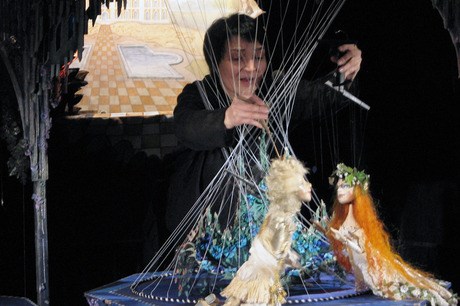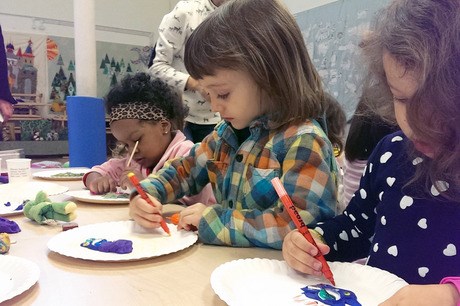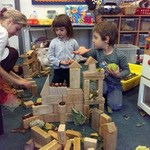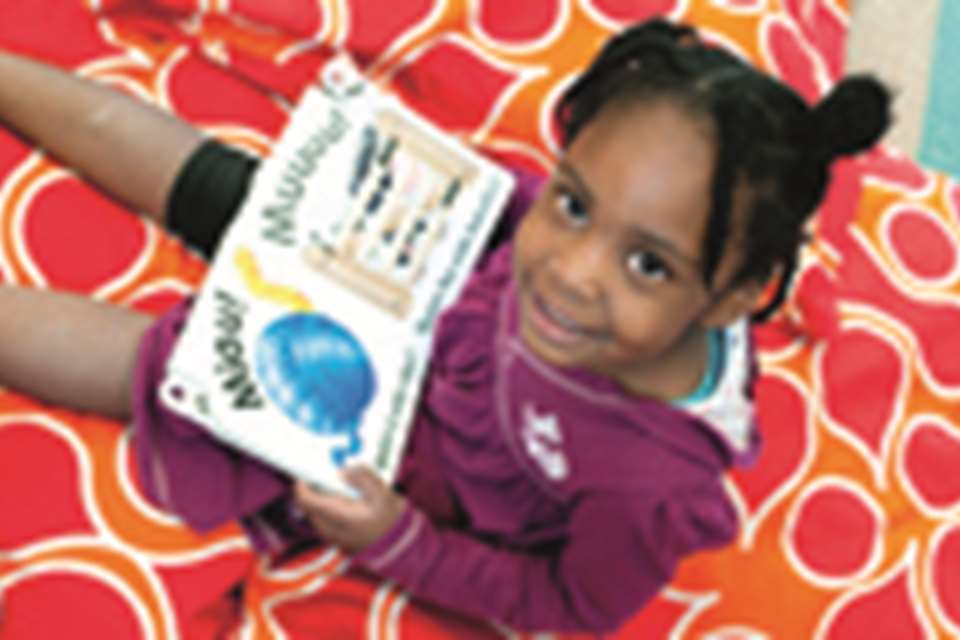Enabling Environments: Bilingualism - Best of both worlds
Monday, April 4, 2016
A Russian-English bilingual school in London is giving children a unique learning experience, finds Karen Faux

The traditions of Russian theatre, music and dance are very much alive and kicking in the nursery at the Azbuka Russian-English Bilingual School in West London. Children enjoy regular visits from Russia’s traditional Petrushka Puppet Theatre, and the nursery has made large wooden puppets of its own, including Dunja. Now 14 years old, Dunja is a favourite with the children and a character that features in role-play activities based on national folk stories.
Nursery teacher Oksana Pavlykivska says, ‘Our children love using role-play and adapting their voices and personality to a different character they are portraying. Drama supports bilingualism, as children develop their oral language skills, their ability to listen and wait for their turn, and use their knowledge of both English and Russian stories to create narratives of their own.’
Drama and music activities based on Russian culture are important to the ethos of Azbuka. Just under half of those attending are from families whose first language is Russian, while others have first languages including German, French and Thai.
Its team of seven EYFS teachers all speak English and Russian, and use an immersive language approach, which is responsive to the communication needs of each child. Teachers work flexibly with a balance of English to Russian across the EYFS areas of learning, and aim for growing fluency in English by the time the child is five to six.
ACHIEVING A DREAM
In 2002, the Azbuka Russian-English Nursery was the first Russian ‘immersion’ nursery to be registered with Ofsted. In March this year, founder and head teacher Maria Gavrilova achieved her dream of expanding her nursery into an independent school, and opened the doors of its new premises, close to Mortlake Station.
The fee-paying establishment, which has 25 nursery and Reception children, is managed by the Azbuka Foundation, a charity of which Ms Gavrilova is chairman, and its income is supplemented by grants and charitable donations that support bilingual education for all families, regardless of income. The organisation includes a cultural centre and a Saturday school.
Ms Gavrilova believes her mission to integrate Britain and Russia’s educational traditions offers the best of both worlds. She says, ‘Our teachers, who are all native English and Russian speakers, are experienced and qualified to teach in Russia, England and Europe, and draw on long experience of delivering best practice in bilingualism.’
She is a strong advocate of bilingual education and believes that this provision is sadly lacking in England. ‘While our bilingual programme is good for those who have just arrived from Russia or elsewhere, it supports proficiency in both languages for any child whose family values the Russian language,’ she says.
‘Bilingualism enables children to perform well in all areas of learning, and it is great for the social and emotional areas of the curriculum, as it embraces different cultures. Our school is a foundation for sustaining bilingualism into adulthood, which is a fantastic advantage.’
MATHS AND SCIENCE
While language and cultural pursuits are a focus for the nursery, there is also a big emphasis on maths and science. Sue Judge, who has been an English teacher with the nursery since it started, introduces English across all learning areas in the Reception year.
She says, ‘As the teacher with primary responsibility for developing the children’s English, I endeavour to use English as my main form of communication with the children as far as is practically possible. On Mondays I deliver dedicated, morning and afternoon sessions in our Reception classroom with our four-year-olds.’
 Ms Judge uses a combination of games, arts and crafts, songs, stories, online resources and more traditional learning activities to teach the children maths and English. She observes British special events and celebration days, such as Mother’s Day, as opportunities for Expressive Arts and Design and other areas of learning.
Ms Judge uses a combination of games, arts and crafts, songs, stories, online resources and more traditional learning activities to teach the children maths and English. She observes British special events and celebration days, such as Mother’s Day, as opportunities for Expressive Arts and Design and other areas of learning.
‘For the Russian-dominant children, I use the occasional Russian phrase to explain anything unclear, but generally they follow my instructions simply by listening and watching my demonstration intently, and imitating their peers,’ she says. ‘They quickly became engrossed in their own creativity and in their remarkable determination to master English phonics.’
Ms Judge says the simple games such as Ludo or Snakes and Ladders are perfect for the development of maths. ‘Children read off the numbers on the dice and move their counters around the board using English numbers and simple English phrases to comment on the game. Caught up in their own competitive spirit, they make astonishing progress and yet are virtually oblivious to the development of their numeracy and bilingualism.’
Teacher Alena Taylor, who has special responsibility for delivering practice for Understanding of the World, corroborates that bilingualism comes naturally when activities support children’s passions.
She says, ‘It’s not only about exciting projects but the language that we use to describe the details that is so important. Commenting on the processes and naming objects extends vocabulary in both languages. Children interact with each other, learn about social skills and how to be patient and precise.’
Azbuka has created an environment in which all children are keen to participate and belong, and the fact that they are acquiring two languages along the way is an advantage they will enjoy long after they have left.

MORE INFORMATION
RESOURCES
Supporting bilingualism
For a wide variety of articles on the learning and development of young bilingual children and how best to support them (listed below), visit: www.nurseryworld.co.uk.
Advice and support
‘All about…multilingualism and critical thinking’ by Vicky Burghardt, Beverley Barnaby and Leena Robertson from Middlesex University London.
‘All about…bilingualism’ by Tricia Carroll and Anne O’Connor.
‘Dog eats man’ by Professor Elena Lieven – how the very different rules within languages and cultural attitudes to children’s learning affect a child’s ability to learn English.
‘Confused’ by Ludovica Serratrice and Samantha Durrant – the facts and common misunderstandings about the learning and development of bilingual children. (All the above authors are involved with the ESRC International Centre for Language and Communicative Development, www.lucid.ac.uk).
‘Mother tongues’ – the rise in multilingual settings due to increased demand from British parents.
Organisations
National Association for Language Development in the Curriculum provides advice and a forum for learning more about English as an Additional Language (EAL) and bilingual learners in schools.
Its early years guidance and advice – at www.naldic.org.uk/eal-teaching-and-learning/outline-guidance/early-years – includes:
‘Supporting Children Learning English as an Additional Language’.
‘Creating positive environments that promote listening and speaking’ by Priscilla Clarke.
‘Why support bilingualism’, ‘Listening to bilingual children’ and ‘Strategies for early years practitioners’ with Rose Drury and Leena Robertson as contributing authors.
Advice for parents
‘A parent’s guide to…bilingualism’ by Penny Tassoni, www.nurseryworld.co.uk.
Be Bilingual – Practical Ideas for Multilingual Families by Annika Bourgogne.
Raising a Bilingual Child (Living Language Series) by Barbara Zurer Pearson.
Bilingual picture books
Suppliers of popular picture books and stories in a variety of languages include:
Further reading
Bilingualism in the Early Years – A resourceful guide to theory and best practice by the Pre-school Learning Alliance, https://shop.pre-school.org.uk/A042/bilingualism-in-the-early-years
Many Languages, Building Connections: Supporting Infants and Toddlers Who Are Dual Language Learners by Karen N Nemeth
Bilingualism in the Early Years: What the Science Says by Byers-Heinlein – Concordia University, and Casey Lew-Williams – Northwestern University, www.learninglandscapes.ca/images/documents/ll-no13/byers-heinlein.pdf
Supporting Bilingual Children in the Early Years Foundation Stage, www.school-portal.co.uk/GroupDownloadFile.asp?ResourceId=3681142









